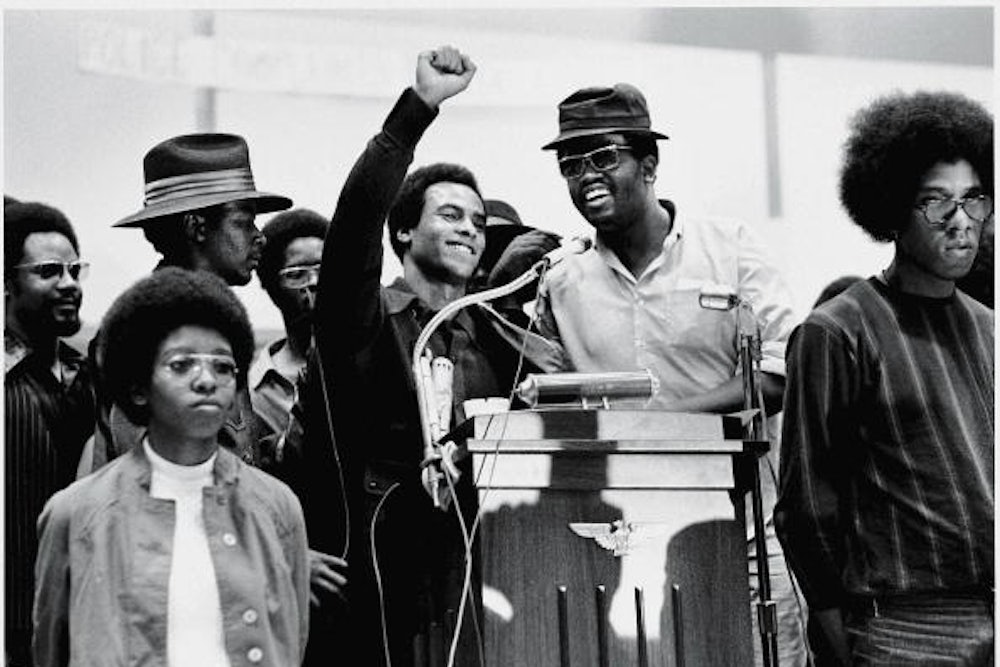Huey Newton’s death from gunshot wounds outside a crack house on the streets of Oakland was the classic demise of the American desperado. Spilled blood defines the shape and the direction of the story, in the cinematic tradition that seems to have had such an influence on him and his followers. The charismatic criminal falls, stripped of all romance, and dies in some scum-sticky situation, like a fly caught on the documentation of his own disorder and degradation. Newton was a cocky and violent man. His times were sufficiently rich with suffering and corruption to permit his admirers to make a myth of him. In his beret, his black leather jacket, his bandolier, holding his shotgun and his spear, hectoring his follower to “off the pigs,” he was really much less than he seemed. He needed a bad boy legend.
Many strange and violent people emerged in those years of the dissolution of the civil rights movement, but one cannot imagine the Black Panther Party for Self Defense starting anywhere but California’s Bay area. There the hallucinatory road to Woodstock and the Manson family intersected with the path of the American Negro. Newton’s story is part of the story of the Free Speech Movement at Berkeley, the strikes at San Francisco State, of Haight-Ashbury, the Symbionese Liberation Army, and of Jim Jones and the mass gulping of poisoned Kool Aid. There was still a wild west in California.
The world Newton traveled in, and the way he traveled in it, was farfetched. Still, it was one of the consequences of social policies that had defaced the democratic foundations of this nation along racial lines. Newton was responding to police brutality, to unequal treatment in the courts, to the irresponsible, even racist, record of J. Edgar Hoover’s FBI. The terrorist activities and the unconstitutional laws that girded Southern society after Reconstruction embittered Newton, like many others, and gave him his moment.
Newton’s defense of the innocent and downtrodden against the powerful grew out of a loss of faith: he did not believe that government would take up the democratic cause of the Negro. And so he advocated violence. It is hard to justify many of his and his followers’ deeds, but as Kenneth O’Reilly has demonstrated in Racial Matters, the actions of the FBI and the resolve of the federal government during the great years of the civil rights movement were so faint of heart that the alienation felt by the Black Panthers was not without reason. The contempt for the dignity and the security of Negroes was unbelievably great. Those were the days when FBI agents merely took notes as civil rights workers were publicly assaulted. O’Reilly shows how the Panthers were undone by counterintelligence and police conspiracies. Yet he doesn’t avoid the fact that the Panthers had gangster tendencies, and that those tendencies fired the combative rhetoric that was known as “murder-mouthing.”
Newton himself said that Malcolm X, clearly the most romantic rabble-rouser of the period, inspired his calls for self-defense, and the early Panther Party’s ten-point program was closely related to that of the Nation of Islam. In the party’s paper, the Declaration of Independence was often cited as justification for taking up arms against unjust circumstances. But the party quickly became a foul-mouthed farce, populated by street thugs who cannot any longer be mistaken for political visionaries. The decline in the movement begun by Rosa Parks and those marvelous young men who sat in at a lunch counter in North Carolina was perhaps most perfectly illustrated by the spectacle of Huey Newton in China, sitting in the Great Hall of the People snorting cocaine and bursting into unintelligible rants, even as elsewhere in the city Kissinger was preparing the way for Nixon. Bravado, self-delusion, and drugs were finally what vied with the tactical brilliance of the Southern Christian Leadership Conference and the (pre-Black Power) Student Non-Violent Coordinating Committee.
Newton went on to become a mere extortionist, perhaps a murderer, certainly an embezzler of funds for a community school. He whiled away his last years seeking one high or another. His death, like that of his namesake, Huey Long, was the death of a demagogue, not the loss of a political visionary. But his dissolution and his death bring Abbie Hoffman’s to mind, and provide still another example of the tragedy that this country has put upon itself by so poorly handling the conflicts that remained when the curtain was rung down on Reconstruction.
O’Reilly observes that “most of the black radicals tried and jailed for murder and other violent crimes knew what they were doing. Some of them no doubt believed they were making a statement, spilling a little pig blood, to use the crude words of the day, for the people. Others came to recognize nihilistic terror for what it was. More than anything else, the notion that those black nationalists who went to war with the state and shot police officers in the back were somehow martyrs is a legacy of the FBI’s counterintelligence program against the Panthers.” That FBI legacy allows for the sustained perversion of political fact in the Afro-American community. Part of the legacy is the ongoing belief in an all-pervasive racist conspiracy exploited by those such as Tawana Brawley, Al Sharpton, Alton Maddox, and Vernon Mason. The other part extends the idea of the street criminal as a radical at war with society, and it is a fitting irony that Newton’s confessed murderer was seeking to work his way up in a drug-distribution gang that calls itself the Black Guerrilla Family.
